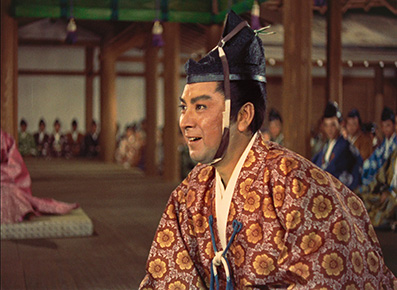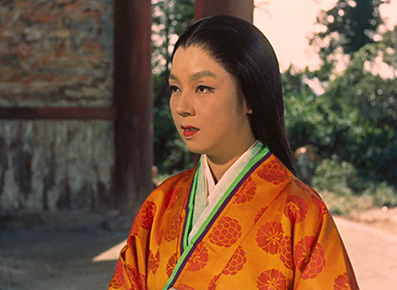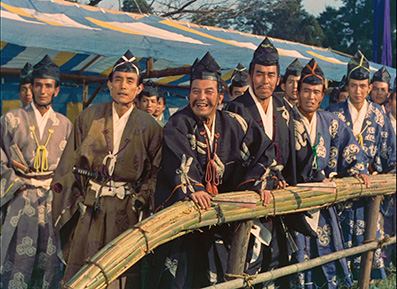| |
"Just as the French impressionists were inspired by classical Japanese woodcut artists, in a similar way there is every possible reason for Western film directors to learn from the Japanese film, Gate of Hell, where the colours really serve their purpose. I would think that the Japanese themselves regard this film as a naturalistic film, in historical costumes, of course, but still naturalistic. Seen with our eyes, however, it seems like a stylised film with attempts at the abstract." |
| |
Carl Theodor Dreyer |
How are you with Japanese names? There's a theory, perfectly sound, that one of the reasons English and American viewers sometimes struggle with foreign language movies is that the character names are unfamiliar, and thus harder for us to remember because we have no real-world equivalent to use as a mental bookmark. I'm currently making my way through Henning Mankell's Wallander books and have lost count of the number of times I've had to hop back a few pages to remind myself who a character is, thrown by my unfamiliarity of Swedish surnames and the seeming similarity of some of them to each other (which I'm sure to Swedish readers are about as similar as Smith and Jones). I mention this only because you'll hear a lot of names in the busy first fifteen minutes of Kinugasa Teinosuke's 1953 Gate of Hell [Jigokumon], and it'll take a sharp ear and a keen memory to keep track of them all. I quickly gave up trying to keep physical notes, as to do so required me to pause the film every few seconds. But don't be put off. This is all set-up for the main story, where you'll only have three characters to keep regular tabs on.
The year is 1159, and rebel forces attempting a coup d'état storm the palace of Lord Kiyomori in an attempt to kidnap the Emperor's father and sister. In order to draw them away, the beautiful Lady Kesa, one of the court's ladies in waiting, volunteers to be disguised as the Emperor's sister and dispatched as a decoy under the protection of loyal samurai Morito. Despite suffering heavy losses, Morito successfully protects Kesa, with whom he subsequently becomes infatuated. Following the eventual suppression of the insurgency, Lord Kiyomori allows his samurai to select their own rewards, and Morito asks that he be married to Lady Kesa. Kiyomori is happy to oblige, at least until it is revealed that Kesa is already married to Wataru, a loyal member of the Imperial guard. But the love-struck Morito is not so easily dissuaded.

All of which appears to cast Morito very much as the good guy of the story, a bold and loyal samurai driven to follow his heart, whatever obstacles might lay in his path. Our bond with him is cemented when his request to marry Lady Kesa prompts his fellow samurai to snigger in amusement, mocking his sentimentality and endearing us to him all the more. We thus share his embarrassment when Kesa is revealed to be already married (news that prompts further guffaws from his fellow warriors) and fully expect him to pursue her anyway in the expectation that her husband will prove to be a heartless brute who takes his wife for granted and doesn't really love her anyway. So it comes as a surprise to discover that Wataru is probably the nicest and most decent samurai in the whole of Japan, one who loves his wife dearly and on whom she clearly dotes. None of which dissuades the determined Morito, who in a disarmingly short space of time – encouraged by Lord Kiyomori's ill-advised attempt at match-making – goes from being the hero of the story to its villain, one who humiliates Wataru by winning a horse race at which he was previously the champion, who tricks Kesa into meeting him by terrorising her aunt, and who threatens to kill Kesa and everyone she cares about unless she submits to his advances.
The tone of what follows will come as no surprise to those well versed in Japanese jidaigeki cinema of the period, which appeared to be as attracted to tragedy as a certain Mr. Shakespeare. That it never quite delivers the emotional punch of the films of Kinugasa's esteemed contemporaries Mizoguchi Kenji and Ozu Yasujirô is perhaps unsurprising given the peerless quality of their 1950s output and this film's aforementioned loyalty switch, which requires us to bond with Wataru in a fraction of the screen time we've spent with Morito. That his pain and humiliation still register so effectively is down to Kinugasa's deft direction and a nicely understated performance from Yamagata Isao, which through a subtle combination of facial expression, body language and vocal delivery, convinces us from the moment we first meet him that Wataru really is the essence of tolerant decency, and that his feelings for Kesa run far deeper than those of his blindly love-sick rival. As Morito, Hasegawa Kazuo (probably best known to western audiences for his lead role in Ichikawa Kon's An Actor's Revenge [Yukinojô henge]) has the most expressive and in some ways most difficult role, required as he is to believably make the switch from upright man of honour to selfish cad. But it's Kyô Machiko's captivating turn as Kesa that impresses the most, convincingly conveying her mixed reaction to Morito's advances without a hint of overstatement and almost solely responsible for the emotional impact of the climax. 
I've seen it suggested that the slight otherworldliness of monochrome is somehow able to cut a more direct route to the heartstrings than the bright colours of Kinugasa's chosen palette, and maybe, just maybe, there's something in that. But what a palette this is, the sumptuous paint-box of Sugiyama Kôhei's Eastmancolor cinematography and Ito Kisaku's lush production design creating as visually vibrant a picture of feudal Japan as you'll find anywhere in subsequent Japanese cinema. And striking though the imagery may be, Kinugasa always uses his camera with purpose, from the breathless confusion and mayhem of opening attack on the palace, to the samurai whose subterfuge is identified immediately by his position in frame and the manner in which he slowly approaches Lord Kiyomori's quarters, an action Morito later emulates during his own act of criminal intent. That said, one of the film's most striking images is memorable precisely because of its artistic composition, an extreme high angle wide shot in which charging samurai emerge from an cover of a tall tree and pause to momentarily become indistinguishable from the leaves against which they are framed.
Although less well known today than some other breakthrough Japanese films of the period, Jigokumon was met with major international acclaim on its initial release, being the first Japanese film shot in colour to be seen by western audiences, winning two Academy Awards (for Best Costume Design in a colour film and Best Foreign Language Film in the United States in 1954), the Palme D'Or at Cannes, the Golden Leopard at the Locarno International Film Festival, and the New York Critics Circle Award for Best Foreign Language Film. And while it does sometimes betray its origins as a stage production and lacks both the storytelling complexity of Kurosawa's Rashomon and the gut-wrenching emotional impact of Mizoguchi's Sanshô Dayû, Jigokumon still makes for enthralling and moving drama and visually ravishing cinema.
The digital restoration here was carried out by the National Film Center of the National Museum of Modern Art in Tokyo and Kadokawa Shoten Co. Ltd., and it has to be one of the loveliest transfers I have yet seen since Blu-ray changed the way we watch movies at home. Yes, there are sharper transfers out there and ones whose colours are more naturalistic, and I'm fully aware that the film's vintage is a factor here (even now I an surprised when older films brush up as well as more recent ones), but the image here is just, well... oh it's gorgeous. The costumes and sets were clearly designed to take full advantage of the capabilities of the Eastmancolor film stock, and the colours are so rich and vibrant that you want to lean into the screen and eat them. The level of detail on some of the medium shots and close-ups is fabulous, lovingly capturing the intricate decoration of the clothing and Ito Kisaku's eye-catching production design; on a couple of shots I was even able to make out the fine weave of the cloth from which Morito's kimono was made. The contrast range is excellent, even in night scenes, and I swear I didn't see a single dust spot anywhere in the film. The screen grabs here don't come close to doing it justice – on a big plasma screen the picture positively shines. A marvellous job.

The film's age is more evident in the Linear PCM 2.0 mono soundtrack, thanks to the usual dynamic range restrictions and lack of bass response, but there is no audible damage save for a slight background hiss. All of the dialogue is clearly audible, and although lacking the depth and clarity of a more modern soundtrack, the increasingly mournful strains and ominous drums of Akutagawa Yasushi's superb score are effectively reproduced and free of distortion.
A rare bare-bones disc from Masters of Cinema, but we do have the expected Booklet, which includes an appreciation of the film by Philip Kemp and a short essay on its use of colour by none other than Carl Theodor Dreyer, plus the expected credits, stills and notes on how to correctly watch the film on a widescreen TV.
A captivating, impressively acted and beautiful looking jidaigeki drama from the golden age of Japanese cinema, restored to its full pristine glory and given an HD transfer to die for. No extras on the disc, but for the film and the transfer alone, this has to come highly recommended.
|